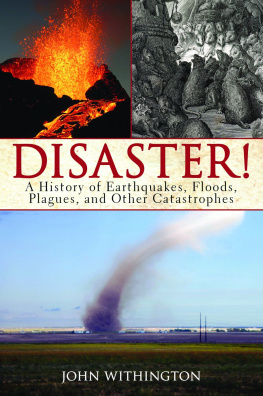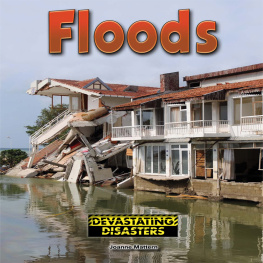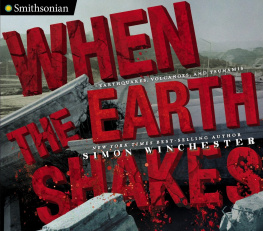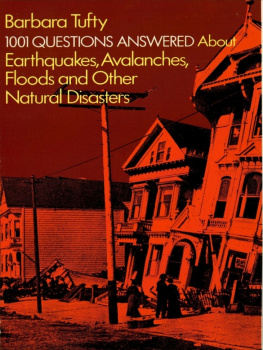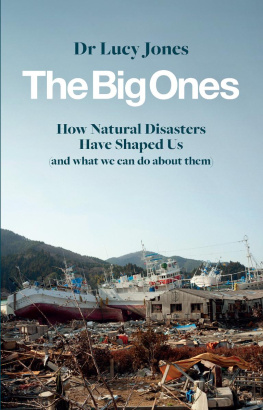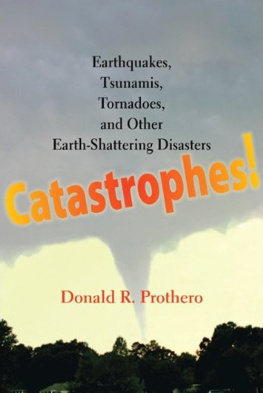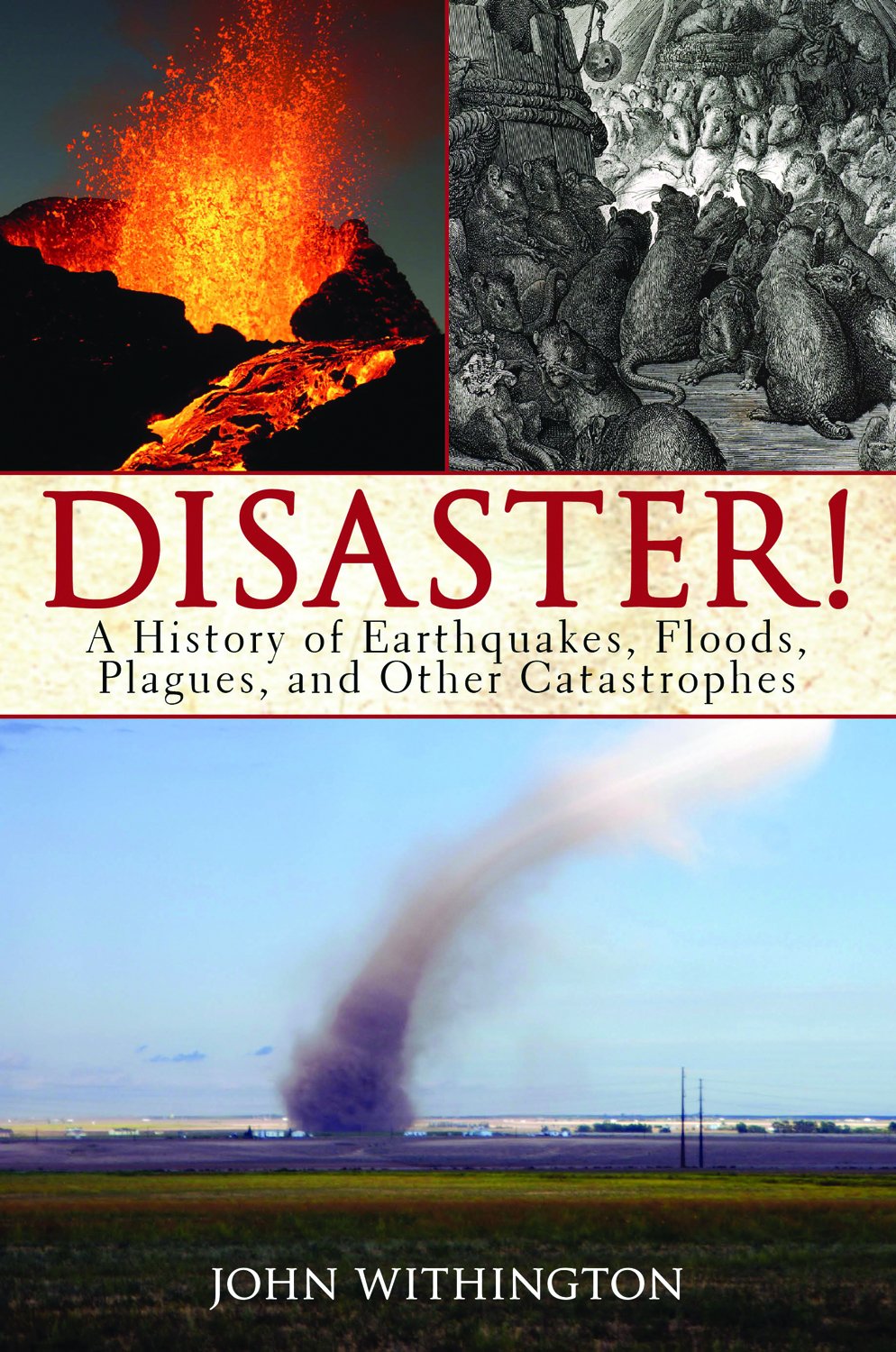O ne of the earliest disasters we know about was also probably the one that came closest to wiping out the human race. About 74,000 years ago, there was a huge volcanic eruption at what is now Lake Toba on the Indonesian island of Sumatra. According to some recently advanced theories, it reduced the earths existing human population of about one million to just 10,000. The eruption was one of the biggest ever, perhaps twenty-eight times as powerful as Mount Tamboras in 1815 (see below), which was the fiercest of modern times. Vulcanologists think it went on for as long as ten days, but as so often happens with volcanoes, the deadliest effect came not from the eruption itself but from the enormous volume of ash flung into the atmosphere, and the effect it had on the weather. Today we worry about global warming, but Toba produced catastrophic global cooling, spewing out an estimated 670 cubic miles of rock that prevented the suns rays getting through to the earth, and plunged the planet into a dark, six-year volcanic winter, with temperatures plunging by up to five degrees. There was also severe acid rain, and plants, animals and our human ancestors died all over the globe as the world was tipped into its last ice age. At one site in central India twenty feet of debris from Toba can still be detected today, while parts of Malaysia were covered to a depth of nearly thirty feet.
Lake Toba lies near a fault line that runs along the centre of Sumatra, one of the weak points in the earths crust, and Indonesia remains probably the most volcanically active country on earth. The ancient eruption gouged out a huge crater which filled with water to create the lake, the biggest in Indonesia and one of the worlds deepest. Fifty miles long, with cliffs up to 800 feet high, today it is a lovely, tranquil stretch of water, and one of the most beautiful features of Sumatra. Sediment from the eruption formed the picturesque island of Samosir in its centre, now a favourite holiday resort.
SANTORINI
A nother of todays tourist paradises is Santorini, a small ring of volcanic islands in the Aegean Sea about 125 miles from the Greek mainland, famous for the spectacular sunsets that can be seen across its circular bay. The bay is actually the rim of a crater, created by a catastrophic volcanic explosion about 3,500 years ago. In those days, Santorini was a single island, ten miles in diameter, rising nearly a mile high to a handsomely symmetrical mountain peak. Along with Crete, it formed one of the ancient worlds greatest civilisations, dominating the eastern Mediterranean for a millennium and a half during the Bronze Age. The Minoans who lived there were a cultured and sophisticated people, who loved sculpture, paintings and jewellery, and had houses with hot and cold running water, toilets and bathrooms.
One dreadful day, their pleasant existence was rudely interrupted by an earthquake. Walls cracked and crumbled, houses collapsed. At this point, many may have departed, perhaps for the Greek mainland, but more likely for Crete, seventy miles away. Not everyone left, though, or perhaps some who did returned later, for there is evidence of paths being cleared and rubble neatly piled up. Someone had set up an improvised cooking hearth outside a ruined building; someone else had hauled a bathtub on to a roof to collect rainwater. We do not know exactly how long it was after the earthquake, but the reconstruction project would come to an abrupt end. The first suggestion that something was amiss was probably another series of tremors. At this point, did the Minoans take flight again? Certainly, there is some evidence that they did. When archaeologists discovered their houses, there were few signs of human remains, or of gold, silver or other valuables, while household utensils and supplies were found in basement storerooms.
For any who did stay, the outlook would have been bleak. A first eruption covered the island with a light fall of pumice, rather like snow. Next came bigger lumps of rock. Then the top of that handsome, symmetrical mountain burst open, and a pillar of smoke and ash rose more than twenty miles into the air, with a bang that could be heard from Central Africa to Scandinavia, and from the Persian Gulf to Gibraltar. The explosion produced a great crater into which the sea flowed, forming the bay that is such a distinctive feature of Santorini today, with its towering cliffs coloured black, grey, pink and rust, around a 1,300-foot-deep sea bed. Thirty-two cubic miles of the island went up in smoke, and a white-hot avalanche descended from the sky on anything left alive on Santorini, covering the island with pumice and debris to a depth of 100 feet. Any of its inhabitants who had taken refuge on Crete would also have been in grave danger as the eruption sent giant waves up to 300 feet high dashing against its coast. Great palaces like the one at Knossos suffered terrible damage. Homes were wrecked, ships sank, and the land was choked and poisoned by vast clouds of pumice and ash, slashing food production. Many believe this disaster marked the beginning of the end of the Minoan civilisation.
It was one of the most powerful eruptions of all time, perhaps second only to Mount Tambora (see below) during the last 5,000 years. For centuries, Santorini remained unoccupied, until the Phoenicians settled there in about 1200 BC, but the area is still volcanically active. Today Thera, the biggest island of the archipelago, has two smaller neighbours nestling in its eight-mile bay Palea Kameni (Old Burned) and Nea Kameni (New Burned) both created by undersea eruptions. It was only in 1966 that archaeologists uncovered, almost intact, an ancient city near the modern town of Akrotiri on Thera. Entombed in solidified volcanic ash, it was dubbed the Pompeii of the Aegean. There were streets and squares, three-storey houses with stone staircases, sewerage and drainage systems and beautiful wall paintings, showing wonderfully vivid and natural scenes of monkeys, fish merchants, elegant ladies and children boxing. Some believe Santorini was the lost land of Atlantis, described by Plato as a great and marvellous power, which held sway over all the island and many other islands, until one day there occurred portentous earthquakes and floods so that the island of Atlantis was swallowed up by the sea and vanished. And could the column of ash created by the eruption be the pillar of cloud the Bible says God sent to guide Moses and the Israelites out of Egypt? Certainly, it would have been visible from the Nile as it soared high into the atmosphere.
POMPEII
O n Santorini, there is a well-preserved town frozen in time at the moment when disaster struck. But nobody knows for certain the fate of the inhabitants. Did they escape? If they did not, what did they think and feel as the cataclysm was about to engulf it? At Pompeii, there is another wonderfully preserved town on an even grander scale, but we also have a vivid account of how its people faced their doom.
By AD 79, a number of towns had sprung up around the base of Mount Vesuvius, thanks to the areas famously fertile soil. Few at the time seemed to suspect that the mountain was a volcano, even though it had actually erupted many times, once destroying a number of Bronze Age settlements. The area was also prone to earthquakes. One in AD 62 caused such widespread damage in Pompeii that seventeen years later it had not been completely repaired. But still the townsfolk refused to leave. Nor were they alarmed that the smoking caverns and volcanic steam geysers of the Phlegraean Fields, believed to be the doorway to Hades, were less than twenty miles from their homes. They were happy to go on harvesting the olives and fruit that grew in abundance on Vesuviuss slopes, while the brilliant sunshine tempered by cooling breezes tempted newcomers to build ever more opulent villas. The town boasted a 16,000-seat amphitheatre, magnificent public baths, and plush brothels and drinking houses.

